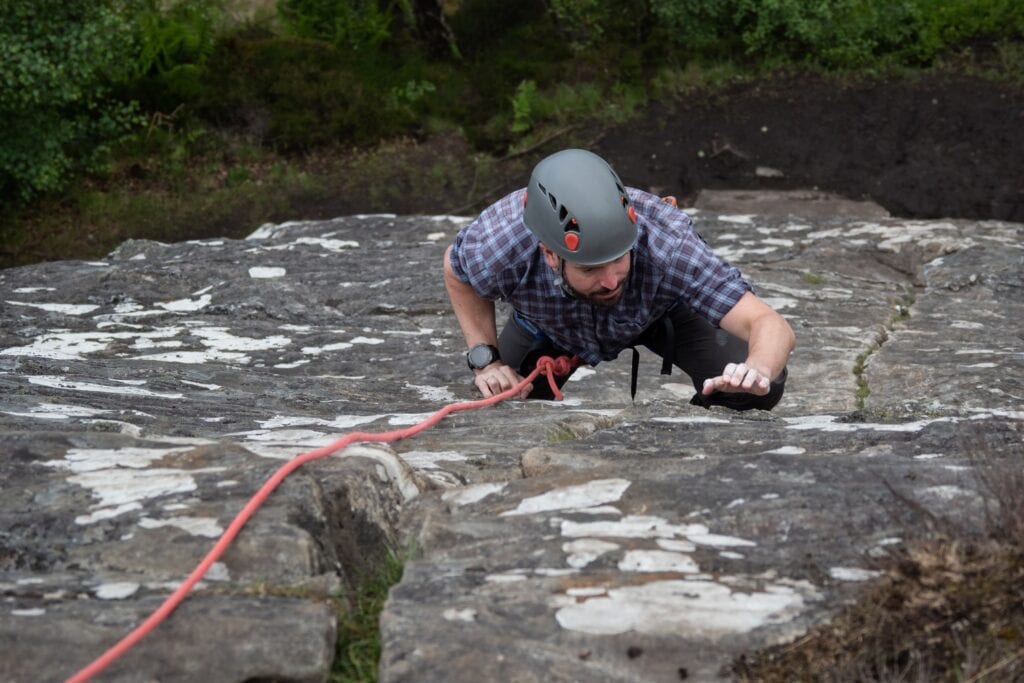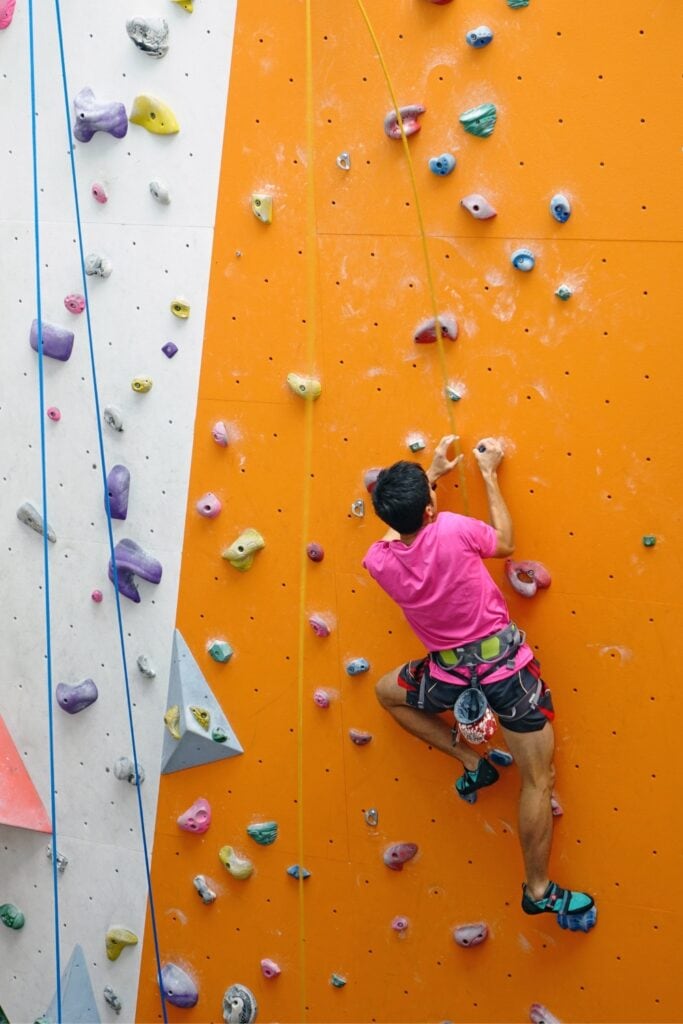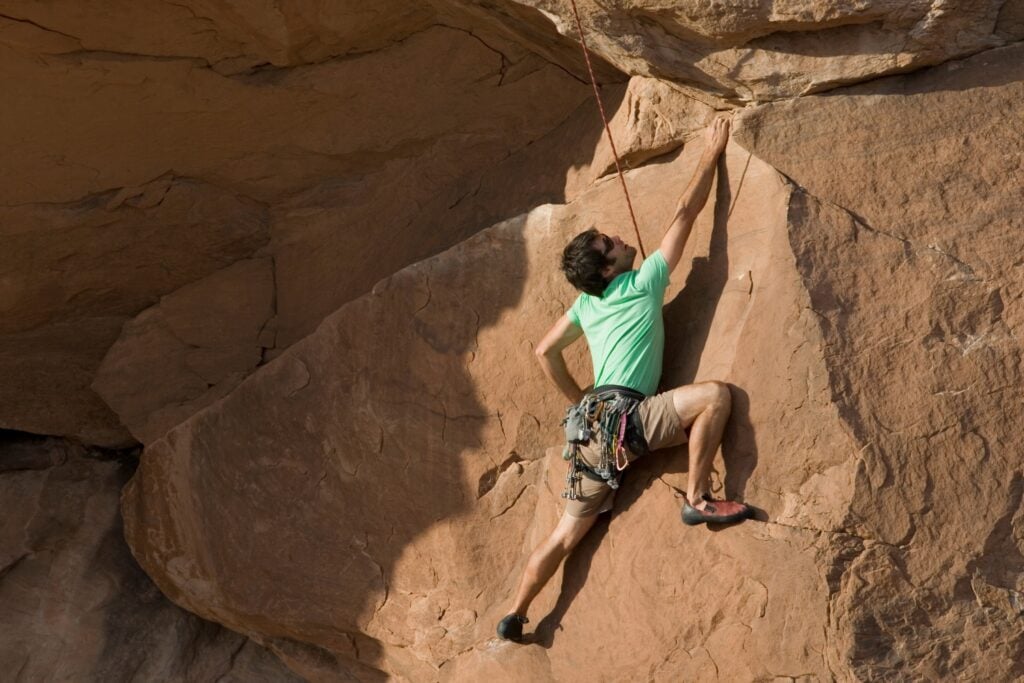Top Rope Climbing: What Is It? (2024 Guide)

Published on: 12/04/2022
If you have ever watched climbers climb outside on the side of a cliff or indoors in a gym using a rope, chances are you were spectating top rope climbing.
Top rope climbing is one of the most popular styles of climbing. Top rope climbing is a favorite amongst climbers because anyone can learn how to climb, it doesn’t require much gear to get started (indoors), and it’s relatively safe– so long as you take the standard safety precautions seriously.
Keep reading to learn about top rope climbing and how to get started.

What’s Top-Rope Climbing?
Top rope climbing, or top roping, is a style of climbing where the climber ties into the end of the rope, which then threads through top rope anchors at the top of the climb and back down to a belayer at the bottom of the climbing route.
As the climber moves upwards, the belayer takes out slack through their belay device so that if the climber falls, the belayer can catch the climber.
In top rope climbing, the climber typically only falls the distance of the dynamic rope stretch.
After a fall or once the climber reaches the top of the wall, the climber is lowered by the belayer.
Top rope climbing can be done inside or outside. On indoor rope routes, the rope is pre-rigged through the anchors at the top of the wall.
However, outside, climbers have to build their anchors at the top of the rock wall. Building safe or “bomber” anchors outside is an advanced skill that takes practice.
Inadequate anchors can lead to severe injury and catastrophic accidents. Therefore, we will have another article that addresses this topic more deeply.

Safety Considerations
Climbing is an inherently dangerous sport. However, of all the climbing styles one can partake in, top-roping is typically safer.
However, even top-roping can lead to serious injury and catastrophic accidents without the correct safety precautions.
- Master belaying under the guidance of a veteran climber or professional guide.
- When climbing outdoors, wear a helmet to mitigate the risk of overhead falling hazards– helmets are for the belayer also.
- Double-check your equipment every time to climb. An effective way to do this is head-to-toe – the helmet’s on and adequately fitted, the harness fits well and is double-backed, and the knot is through both tie-in points and correctly tied.
- Build a bomber or safe anchor that follows the industry’s best practices for strength, redundancy, and dispersing the load (equalization).
- Use the correct gear to ensure everyone in your climbing party is properly outfitted with modern climbing equipment.
Gear for Top Rope Climbing
To start climbing, you must invest in some gear first. However, you will need different gear depending on how you start.
For example, to start in a climbing gym, you’ll need a climber’s harness and climbing shoes. However, to begin top rope climbing outside, you’ll need extensively more climbing gear.
- Climbing helmet
- Harness
- Belay device
- Climbing shoes
- Several locking carabiners
- Personal anchor system
- Chalk bag
- Quickdraws
- Dynamic climbing rope
- Static rope or tubular webbing

Practical Tips to Get Started
1. Join a course
Indoor climbing gyms are the perfect place to learn about rope climbing.
Taking an instructional course and going gym climbing is great because you can learn the basics in a relatively controlled environment.
2. Hire a guide
Hiring a climbing guide is the ideal way to start climbing outside.
Rock climbing guides ensure maximum safety and can teach you new skills – such as how to build a top rope anchor, rappel, lead climb, and, if you’re interested, the basics of trad climbing.
3. Master your skills indoors
Whether you have decided to take a course, hire a guide or learn from a friend, the fact remains the same– before you move to climb outside or begin advanced styles of climbing, such as trad climbing, sport climbing, or alpine climbing, you need to master the basics.
For example, double-checking equipment, keeping a taut rope, arresting a fall, tying a backup knot at the end of the rope, building anchors, lowering a climber, and properly loading your belay device should all be second nature. Doing this indoors (and even on the ground) is the ideal place, not on a cliff edge.

Next Steps
Typically, when beginner climber reaches mastery of top-rope climbing, and they want to continue learning new skills, it makes sense for them to evolve to lead climbing.
Learning to lead climb is an obvious progression because it builds on the climbing and belaying skills you learned while top rope climbing while adding new skills like clipping quickdraws, leading, and belaying a leader.
Frequently Asked Questions (FAQs)
Top-roping is not the same as belaying. However, belaying is involved in the activity of top-roping.
In top-roping, a climber ties into the climbing rope. Then, on the other side of the rope, a belayer loads the rope into a belay device. As the climber moves upwards, the belayer takes slack out of the system to keep the climber safe if they fall.
At the end of the climb, the belayer lowers the climber to the ground.
Top-roping is a friendly style of climbing that is ideal for beginners.
However, it’s for more than just beginner climbers. More experienced veteran climbers enjoy it also. Climbers of all ability levels enjoy it because of how safe this style of climbing can be.
Between the two climbing styles, most experienced climbers would say that bouldering is more challenging than top rope.
Bouldering is considered more difficult because the movement can be more powerful and acrobatic than climbing on a top rope.
Top-roping is a style of climbing where the climber already has the rope secured into an anchor at the top of the route.
This is different more lead climbing because, in lead climbing, the climber brings the rope with them as they climb upwards and does not have it secured to a top anchor point.
